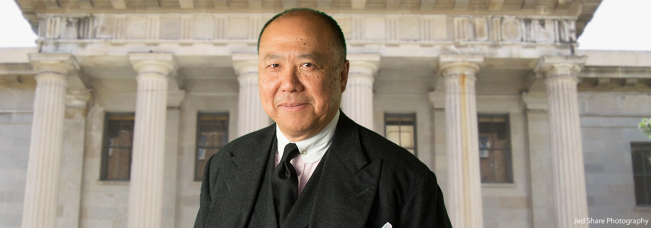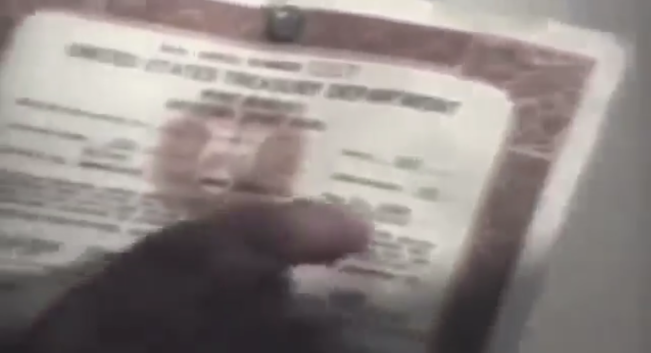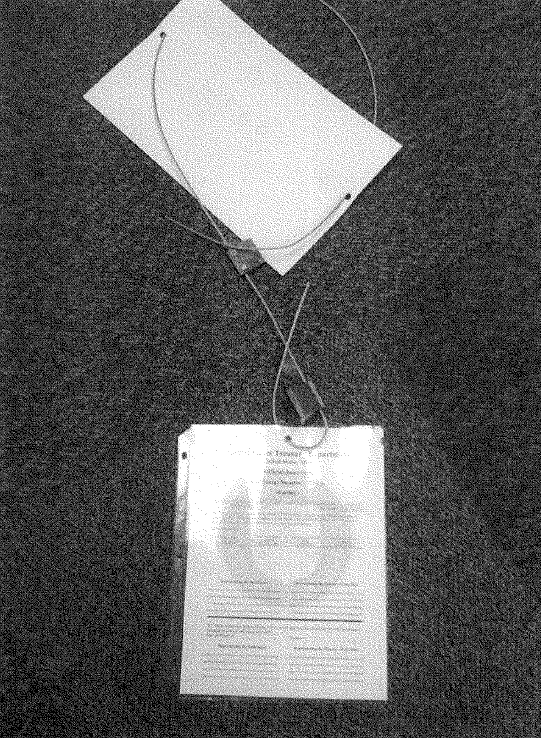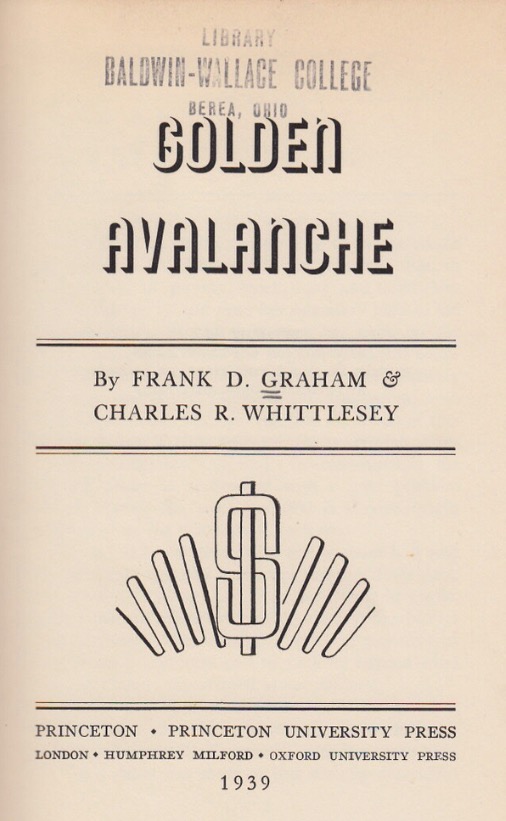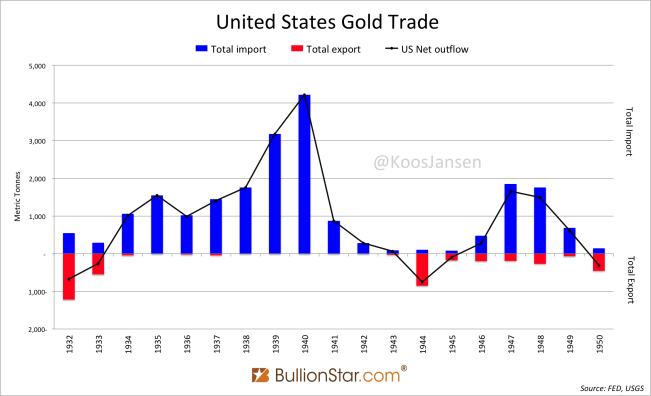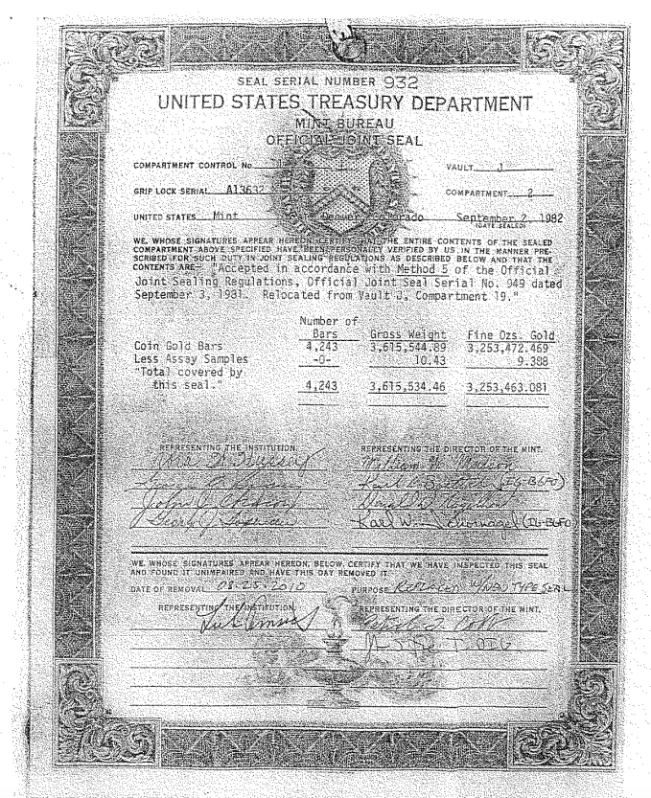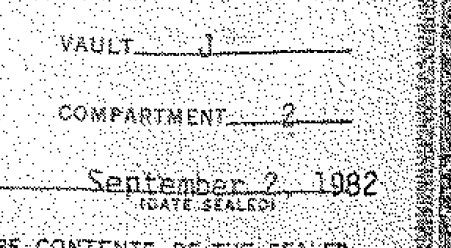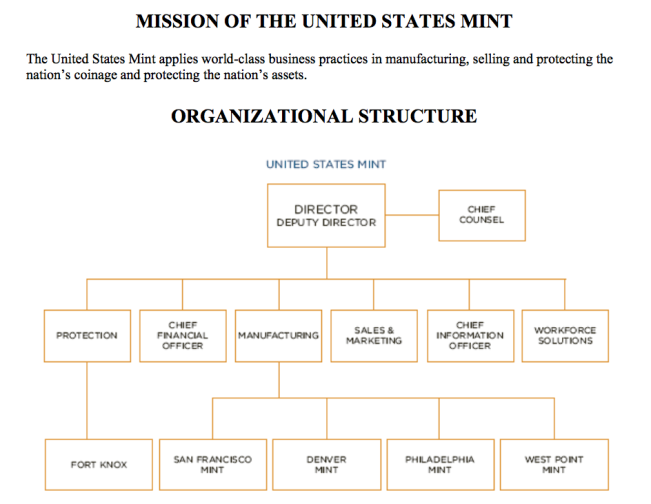Former U.S. Mint Director Clueless On Gold In Fort Knox
The Curious Case Of Edmund C. Moy
Former US Mint director Ed Moy has made numerous false and self-contradictory statements regarding the gold at Fort Knox – a facility managed by the US Mint.
The is post is a sequel to A First Glance At US Official Gold Reserves Audits, Second Thoughts On US Official Gold Reserves Audits and US Government Lost 7 Fort Knox Gold Audit Reports. Also related is Where Did The Gold In Fort Knox Come From? Part One.
Recap and Introduction
Early 2014 my first post was published about the audits performed on 95 % of US official gold reserves – the 7,628 tonnes stored by the US Mint – this is referred to as Deep Storage gold, 4,583 tonnes is at Fort Knox, 1,364 tonnes in Denver, 1,682 tonnes at West Point. In total US official gold reserves account for the 8,134 tonnes, owned by the US Treasury. My focus has always been the gold at the Fort Knox depository, as this is the largest facility. At the very surface the official story presented by the US government regarding the existence of Deep Storage gold seems credible. However, while investigating we could observe the official story is anything but credible.
During my research I’ve reached out to Edmund C. Moy, 38th Director of the US Mint from 2006 until 2011, who was very helpful in answering all of my questions over Twitter and email. Although this gentleman has been very cooperative, many of his statements in various media and emails appeared to be false and self-contradictory. For the sake of simplicity we will focus on Moy’s statements at a coin expo in 2013, an article he wrote for Newsmax Finance early 2014 and emails he wrote me in response to my questions.
Moy has given me permission to publish the emails he sent to me.
1. False Statements At Coin Expo November 2013
It al started with a video from the Whitman Coin And Collectables Exposition in Baltimore November 2013. Below you can find the video:
1.1. What Did Moy See At Fort Knox?
Let’s go through this, quote one: “I’ve been inside of Fort Knox, and I’ve seen the gold. So I know it’s actually there… I can personally vouch there is gold at Fort Knox and I personally have seen it”. On camera Moy states he has seen a good portion of the gold at Fort Knox, which has assured him to vouch for the existence of the gold. Although a visual inspection of 446,698 gold bars will not pass as an audit, what we’re analyzing is, what did Moy actually see? From the video you would think he was granted access to the vaults and properly saw (and touched) the gold in all compartments.
As was published in a previous post, allegedly 100 % of the gold at Fort Knox has been audited in between 1974 and 1982 during the Continuing Audit Of US Government -Owned Gold program. After these audits all vault compartments were placed under Official Joint Seal (before the Continuing Audits program the compartments were under Official Joint Seal as well). From film footage inside Fort Knox in 1974 we can see a corridor with vault compartments covered with the seals.
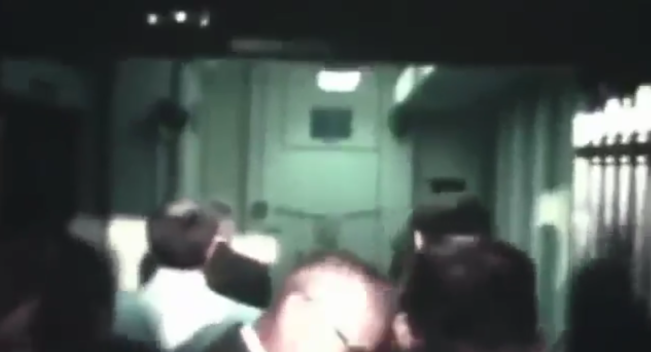
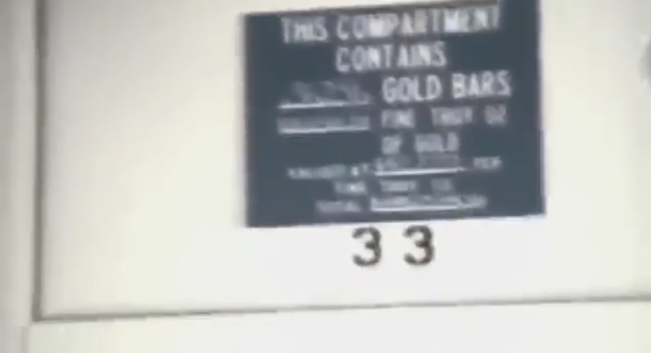
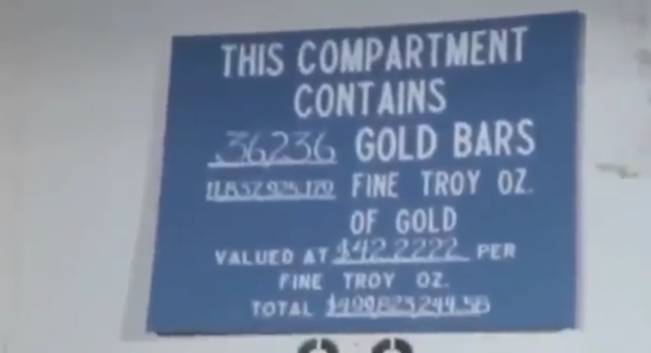
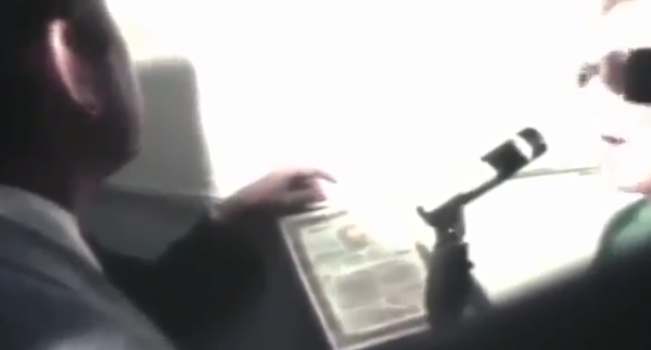
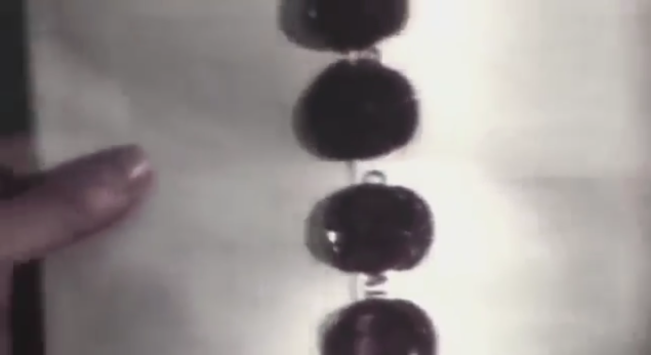
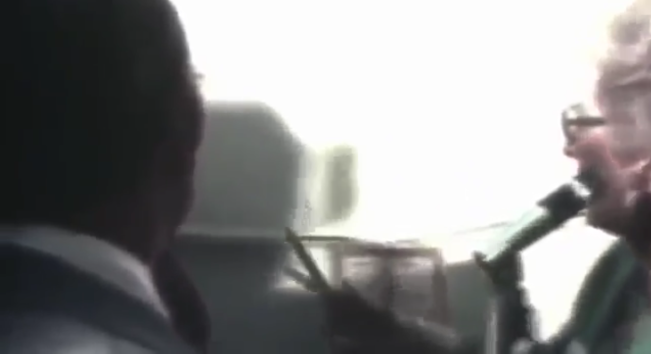
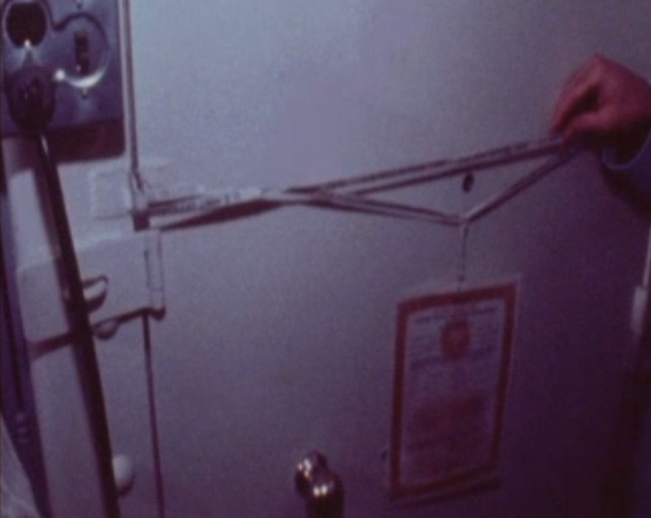
At the end of the corridor we can see vault compartment 33. In front of the vault door there is a ribbon waxed to an Official Joint Seal. It is impossible to open the vault without impairing the ribbon. We can see no window in the vault door of compartment 33 (first pictures), only a very tiny peephole (last picture). At this point we can raise the question to what degree Moy has seen the gold while vault compartments are sealed and there are only tiny peepholes in the compartment doors. From my judgment looking through a peephole at best confirms there is yellow stuff on the other side.
The Treasury Office Inspector General (OIG), which is currently responsible for the Deep Storage gold audits, has told me it is absolutely not routine to break the seals. Neither for inspection by a US Mint Director nor for the President of the United States will the seals be broken. There is one possibility Moy could have properly seen the gold; in 2010 the US Mint renewed all the Official Joint Seals, the ones put in place after 1974 with the delicate ribbon and wax were replaced for new plasticized seals with steel cables. (Yes, technically at that moment the seals were renewed all 42 Deep Storage compartments could have been opened.)
There is a possibility Moy properly saw the gold if he was present when the seals were broken and the doors opened before the new seals were put in place. At the Gold Transparency Act in 2011 the OIG stated:
More recently the Mint decided to replace all of the previously placed Official Joint Seals with new seals. The new seals are more durable, having a double security barrier seal that can only be removed by two cuts with a strong cable cutter.
The Mint replaced all of the previously placed Official Joint Seals with new ones during fiscal year 2010. The seal replacement process consisted of two steps: (1) inspection of all previously placed Official Joint Seals on all the compartments containing deep storage gold to determine whether they had been altered or compromised in any way, and (2) placement of a new Official Joint Seal. The seal inspection and replacement process was carried out for all 42 deep storage gold compartments, in the presence of a Treasury OIG auditor, by a Mint headquarter staff person, representing the Mint Director, and a Mint storage facility staff person, representing the facility’s Plant Manager. For each Official Joint Seal removed, the Mint headquarters representative, the Mint storage facility representative, and the observing Treasury OIG auditor signed an inspection report; the same parties also signed the new Official Joint Seal that replaced the one removed.
The report mentions “a Mint headquarter staff person, representing the Mint Director” was present when the seals were renewed, not the Mint Director himself. Concluding Moy was not present when the seals were renewed, therefor he only could have seen the gold through the tiny peepholes.
1.2. Not All Gold Fort Knox Supplied By Confiscated US Coins
Quote two, “And these bars up at Fort Knox are … looked like dirty gold with some corrosion on them and they’re not as yellow. … And then you realize, Roosevelt had made it illegal for Americans to physically possess gold coins, and he melted all those gold coins and that’s what ended up being the initial stock at Fort Knox. A lot of those coins were 22 karat gold which then have impurities. You know and a lot of it wasn’t refined when it was made into these bars that ended up making it into Fort Knox. When you take a look at them, at each bar, you realize what history is behind it, how many coins must have been melted in order to make the bar, and what life stories must’ve been part of all that.”
Moy describing how all gold coins that circulated in the US in 1933 were confiscated by President Roosevelt and filled the vaults in Fort Knox is only partially true. In 1933 gold coins in the US accounted for 2,515 tonnes, of which 1,901 tonnes were already held at banks and the government. The difference, 614 tonnes, could not have made US gold reserves increase by 13,041 tonnes (from 6,505 tonnes in 1933 to 19,546 tonnes in 1940). The dramatic rise in US gold reserves was caused by imports – as was demonstrated in my post Where Did The Gold In Fort Knox Come From? Part One.
Before Word War Two it was common knowledge that the increment of the US official gold reserves and thus Fort Knox was due to imported metal. One book that I know of was published in 1939, it’s titled Golden Avalanche; it describes how the devaluation of the US dollar against gold in 1934 triggered a global mining boom and an avalanche of gold that hit the shores of the United States.
I’m not sure exactly when and why “experts" started spreading the myth about the US coins that filled Fort Knox.
1.3. The Gold In Fort Knox Is Not Yearly Audited
Quote three, “So once a year the US Mint police coordinates with the Treasury Inspector General, and coordinates with the Mint chief financial officer, and they have to audit the gold. When you take a look at these bars, each one is numbered. They have to be taken out, counted, and assayed, to make sure they still have everything in it that they’re supposed to. When it’s all done they’re put back in in the same order as they have been taken out. So when you take a look at these vaults, again I can’t tell you how much is in there and how they’re organized, but there is a lot of bricks in there.”
This is simply not true. The official story from OIG is that 100 % of the gold stored at Fort Knox was audited in between 1974 and 1986. After 1986 the gold at Fort Knox has not been not audited every year. Apparently Moy has always been unaware of the audit procedures at the US Mint while he was the Director of this institution and presents himself as an expert. Did Moy have any sight or control over the Deep Storage gold when he was in office?
2. False And Contradicting Statements In Moy’s Newsmax Article
In June 2014 Ed Moy published an article about the gold at Fort Knox at Newsmax Finance. From Moy’s appearance at the coin expo and this article it seems he’s on a mission to debunk rumors that suggest Fort Knox is empty. Unintendedly he’s feeding the speculation. In his article Moy has changed his mind on several topics, he starts by saying the minority of the bars in Fort Knox are coin bars (roughly 90 % pure). From Moy’s article:
Is There Gold in Fort Knox?
A minority of the bars were made from the melted coins and have a tarnished appearance because the coins were only 90 percent pure gold. …The majority of the bars are standard 400 ounce good delivery bars.
Opposite to what Moy said at the coin expo he writes a minority of the bars at Fort Knox are 90 % fine and the majority are Good Delivery bars (this suggests they are above 99.5 % pure). This cannot be true. In 2011 a detailed bar list was published by the US Mint that shows the vast majority of the bars are roughly 90 % pure. To be precise the Fort Knox gold has an average fineness of 91.67 %, 83 % of the gold at Fort Knox are coin bars (roughly 90 % pure), 17 % of the gold is Good Delivery (> 99.5 % pure). Yet, Moy was not aware of the bar list at his own facility.
More from the Newsmax article:
In 1953, the U.S. Department of the Treasury and the General Accounting Office (representing Congress) conducted a full audit of the gold at Fort Knox. Each bar was removed, documented and cross-referenced. Five percent of the gold was randomly assayed.
In 1974, then-Mint Director Mary Brooks led the first-ever public tour of the classified facility. The 120 visitors included members of Congress and the news media. …. When the delegation was satisfied, the vaults were again carefully sealed.
Each of the years I was Mint Director, the Inspector General of the U.S. Treasury and the Office of the Chief Financial Officer of the U.S. Mint conducted an audit of the gold in Fort Knox. Each of the vaults is sealed with a special tape that is designed to show any forced entry. The audits since the last full audit in 1953 have been mainly checking to make sure the seal has not been broken or tampered…
Apparently Moy had changed his mind about when and how the Fort Knox audits were performed. On the coin expo he shared the gold is physically audited every year, one year later we’re told the gold was audited in 1953. Typically, both statements are in conflict with the official story. In 1953 a meager 13.6 % of the gold was audited (the details of the 1953 audit can be read in the audit report from 1953), and since 1953 the gold has not been physically audited every year – most audits were performed from 1974 until 1986.

How hard can it be to at least verify the official story before writing an article? It’s hard to believe Moy had anything to do with Deep Storage gold during his tenure as US Mint Director.
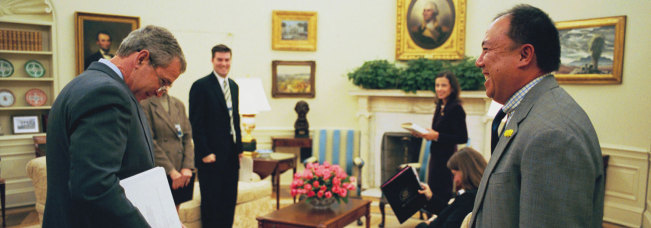
3. Email Correspondence Anything But Convincing
My first question to Moy over email was about his statement at the coin expo, “every year the bars have to be taken out, counted, and assayed, to make sure they still have everything in it that they’re supposed to”. Moy replied:
The video is from a beginner’s coin collector seminar I gave at a Whitman Coin & Collectible Expo. Because of the audience, I had to simplify my remarks, especially with this question during the Q&A session. So it came off implying something incorrect. Until 1953, there were serial number audits of the gold and some assaying as I explain but that became costly and time intensive. The last full audit was done in 1953 (my understanding was that it was a serial number audit with random assaying of 5% the bars and did not use outside auditors). All the vaults with the audited bars were then sealed with tape and wax in a way as to tell if the seal has been tampered with.
In this instance it’s my humble opinion his remarks could have been simplified without corrupting the essence. Besides, coin collectors are not audiences that need a kindergarten version of a procedure that is plain and simple of itself: the gold was (allegedly) audited from 1974 until 1986 and placed under Official Joint Seal, after which the seals have been checked every year. Remarkably, he’s making it worse by mentioning the last full audit was in 1953, which is not true.
Second, because there was a very slight possibility he could have properly seen the gold in 2010 – when the seals were renewed – I decided to ask when exactly he saw the gold.
Me:
In what year did you see the gold at Fort Knox? Or did you see it every year when you were in office?
Moy:
I saw it for the first time at the end of 2006 and at least once a year every year thereafter when I was mint director.
Me:
…how could you have seen the gold if all compartments were placed under Official Joint Seal during the continuing gold audit program from 1974 – 1986?
Moy:
Each compartment’s door has a small window in it. Further, each compartment has an interior light that is controlled by a switch on the exterior wall near the door. My inspection consisted of inspecting the seal, turning on the light, and visually inspecting the gold in each compartment.
Moy confirms all he has seen was through the peepholes – a visual inspection that doesn’t impress me. More importantly, Moy states he inspected the seals every year. Let’s have a look at one of these old seals that came of a Deep Storage compartment in 2010 (Vault J, compartment 2, Denver).
On the seal there a two dates stamped:
We whose signatures appear hereon certify that the entire contents of the sealed compartments above specified have been personally verified by us in the manner prescribed for such duty in joint sealing regulations as described below an that the contents are accepted in accordance with method 5 of the Official Joint Sealing Regulations, Official Joint Seal No. 949 dated September 3, 1981. Relocated from Vault J, Compartment 19.
And…
Moy claims to have inspected all seals at least once a year. Did it ever occur to him the seals were not stamped in 1953? His most recent assumption (Newsmax article) is that the last full audit was conducted in 1953, while all the seals he inspected must have been stamped after 1974. Are we supposed to believe the Director of the Mint could have missed the date on the seals, which grants the safety of the largest stock of wealth on earth at the facilities he guided, numerous times when he inspected them? At this point it is safe to say Moy’s inspections of the Deep Storage gold carry little significance in terms of proof there is gold at Fort Knox.
Next, I asked Moy how come he wrote in the Newsmax article the minority of the bars are 90 % pure and the majority is Good Delivery, while according the official excel sheet it’s exactly the other way around. Moy replied:
That is what I was told by the Fort Knox protection staff. I would recommend a FOIA request from the IG or the US Mint posing the question to get an official answer with appropriate documentation. That way you could be the first to break the news. FYI, my visual inspection of all the vaults at all three facilities showed a mixture of good delivery and coin bars (you can easily tell the difference between the two just by looking at them).
When he was in office Moy knew little about the gold (as you may have guessed by now), as he was informed about it by the Fort Knox protection staff. It appears Moy had little authority over the Deep Storage gold. A FOIA regarding the bar list is not necessary, neither is breaking the news, as this information is already publicly available – since 2011.
Lastly, Moy turns again and writes me the gold he saw at Fort Knox was a mixture of good delivery bars and coin bars (in the Newsmax article the majority was supposed to be Good Delivery). Depending on the definition of “mixture”, what he finally wrote over email could be correct – 17 % of the gold at Fort Knox is Good Delivery. (According to the bar list there are 759 tonnes of Good Delivery gold at Fort Knox, in total there are 4,583 tonnes of gold stored in 15 compartments)
4. Conclusion
Taking everything Moy has said and written in consideration it’s very weird he has been so outspoken while having done “little homework". Many documents have been publicly released from the Gold Transparency Act in 2011, but Moy still is poorly informed on the audit procedures and the bar list, resulting in very unfortunate public statements. The fact he still (after 2011) is wrong on the audits and bar list mainly points out his personal incompetence, which makes everything else he has said and written useless for our analysis regarding Deep Storage gold. What do his erroneous statements proof? Well, by all means, they do not proof there is gold at Fort Knox.
Keep in mind Moy’s proposal is for Congress to authorize a new comprehensive audit. Maybe he’s not so sure if he saw the gold after all.
@NotoriousCLO @HereTizz @KoosJansen Not much but wouldn’t satisfy him. IMO there should be a comprehensive audit authorized by Congress.
— Edmund Moy (@EdmundCMoy) January 19, 2015
Popular Blog Posts by Koos Jansen
 China’s Secret Gold Supplier is Singapore
China’s Secret Gold Supplier is Singapore
 Audits of U.S. Monetary Gold Severely Lack Credibility
Audits of U.S. Monetary Gold Severely Lack Credibility
 China Gold Import Jan-Sep 797t. Who’s Supplying?
China Gold Import Jan-Sep 797t. Who’s Supplying?
 The Gold-Backed-Oil-Yuan Futures Contract Myth
The Gold-Backed-Oil-Yuan Futures Contract Myth
 Estimated Chinese Gold Reserves Surpass 20,000t
Estimated Chinese Gold Reserves Surpass 20,000t
 Did the Dutch Central Bank Lie About Its Gold Bar List?
Did the Dutch Central Bank Lie About Its Gold Bar List?
 PBOC Gold Purchases: Separating Facts from Speculation
PBOC Gold Purchases: Separating Facts from Speculation
 U.S. Mint Releases New Fort Knox Audit Documentation
U.S. Mint Releases New Fort Knox Audit Documentation
 China Net Imported 1,300t of Gold in 2016
China Net Imported 1,300t of Gold in 2016
 Why SGE Withdrawals Equal Chinese Gold Demand and Why Not
Why SGE Withdrawals Equal Chinese Gold Demand and Why Not






 Koos Jansen
Koos Jansen